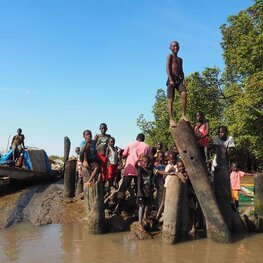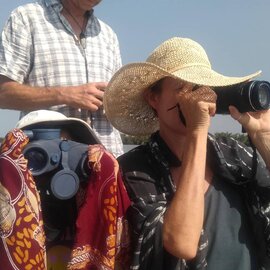Gambia: Skirting the Covid Chaos
Having cruised extensively last year from South Africa to Europe, Kia Koropp and her family decided to forego an Atlantic Crossing to the Caribbean in November and instead headed down to Gambia for an alternative cruising experience up-river with hippos and crocodiles.
Published 4 years ago


While the clearance process can be a hectic third world experience, everything since then has been quite relaxed and rewarding.
Clearance Process:
Yachts need to visit the following offices on arrival in Banjul:
- Customs – forms to be filled and stamped. No onboard visit was made by customs officials, although policy is that one should be done. No questions asked, nor did they ask any specifics on anything brought into the country. A small ‘office contribution’ 3USD was made to help with this. The process was consistent with the other three cruising yachts that entered before us this year.
- Immigration – 30 days entry on arrival. The tourist visa is free for many passports (inc. EU and NZ). A visa is required for USA passports, which can be issued on arrival or bought in advance. The fee for the USA passport was 3000 Dallasie (about 50USD). After 30 days, entry can be extended for a fee of about 15USD for another 30 days. The process was consistent with the other three cruising yachts that entered before us.
- Health – officials may meet you on the arrival jetty. Official govt requirements are unknown, but Banjul port health officials say that it is a requirement to have EITHER a negative Covid test (taken within 14 days of arrival) OR a quarantine period of 14 days applies with seatime deducted from overall time. Quarantine would have to be done at a specified hotel at the travellers expense.
- After discussion, it was agreed that for the 4 yachts arriving in Dec 2020 a temperature test would be accepted and all were allowed entry. The process varied widely for each boat that entered, with “donations” accepted and probably now expected; usually Health is not involved in the clearance process, so perhaps there is confusion over how to handle the process.
- They asked for crews vaccinations records. They didn’t seem to look for anything in the books specifically, but it was very important that we had the booklets.
- Port Office – there is a charge of 22 Euro for the Port fees and River Cruising Permit, but this must be paid in local currency. A receipt is given. The River Permit does not have an expiry date, however they do ask your intended length of stay on arrival and this is written on the form.


Lamin Lodge is a great place to go to after clearance to avoid the dusty bustle of Banjul (5 miles upriver) and get sorted in a relaxed environment before moving inland. The owner of Lamin Lodge died about two years ago and the lodge itself has deteriorated, but there is a friendly atmosphere ashore and the boys that hang just outside the lodge are used to yachts and can assist with all services (provisioning, water, fuel etc.). In addition, they are very friendly toward visiting yachts and include visitors socially (shared meals, drumming sessions, drinks in the evening and all can be arranged by request). I recommend yachts head there before venturing further upriver.
For a journey up the river, cruisers should consider the following:
Why Gambia: There are three main experiences that will define your trip up the river: The silence and solitude of the creeks, the sight of unique wildlife up the river, and the warm welcome of the locals in the villages. Each of these will make your trip a special experience; combined they will make your trip exceptional.
Villages: English is widely spoken and people are friendly and helpful. You will be greeted either by pirogue or ashore by a crowd of children, and most likely escorted around town by a self-nominated adult who will make you welcomed into the village. People are extremely helpful if needing assistance, and you are often welcomed into their homes. These connections made will be a highlight of the journey up the river.
Wildlife: If you are interested in bird life, the creeks will keep you well engaged in the myriad of different species and the continuous birdsong. You’ll see the signs of hippo and crocodile in the entrance holes and matted reeds on the banks of the creeks, and monkeys will bound between the trees. With luck you will see hippo and crocodile in the lower reaches of the river, but you are almost certain to see them between Bird Island and the National Park. If you enter the park with a ranger, they will call the chimpanzee to the trees along the banks and you can spend some time watching them a few meters from your dinghy or boat.
Depth: The river is deep for most of the way, but a draft of more than 2.5m would make exploring some of the smaller creeks more difficult. Expect the mouth of the creek to get shallow before it gets deep, so don’t let the entrance deter you from exploring further. Also, it is often deepest closest to the mangroves, so if navigation gets difficult steer towards the side of the river for deeper water.
Height: The most interesting part of the river lies between the Gambia bridge (17m) and a power cable that runs across the upper river (11m in the middle, smaller yachts can pass on the side of the river, but must use caution) just after Georgetown. If you can get past the bridge, you can access the creeks and the National Park where you will get your crocodile, hippo and chimpanzee sightings, all of which are before Georgetown at the other end.
Distance and timing: Be prepared to motor 160 miles up river since this will take you to the National Park. One can go further (smaller yachts), but this covers the most interesting part of the river. If you are not prepared to do this distance or can’t get under the bridge, it’s almost not worth visiting Gambia. All the best stuff lies between the bridge and the National Park.
We took three weeks to go up to the National Park and back down. If under time pressure, it would be possible to do it in less time, but due to distance and tide you are confined to about 30-35 miles per tide, and you want time to sit on the creeks and enjoy the solitude and wildlife, or time in the villages to enjoy the friendly locals who welcome you. It is possible to move against the tide, but obviously it would take more time and you would use more fuel.
Anchoring: You can anchor in mud almost anywhere on the main river. The best anchorages are in some of the smaller side creeks where you will be surrounded by nothing but bush and bird life, and the occasional crash of a croc into the water or grunt of a hippo.
Mosquitoes: Insects were not as much of a nuisance as we’d expected, but they will become more prevalent the further up the river you go. You will want to be prepared with repellant and mosquito netting, particularly against mosquitoes at dusk from Bird Island onwards.
Fuel: If you need to refuel, there are a couple of towns where fuel can be obtained, but it will need to be jerry canned back to the boat.
Water: It is not advised to run a watermaker in the river. The water ashore is generally good quality well water, but ask local permission as a courtesy. It will need to be jerry canned back to the boat, and if you wish for assistance the local villagers are usually very willing (a small fee is a nice compensation for their efforts).
Food and provisions: Most of the villages along the river have small plots of land for cultivating their own vegetables for personal use, so it is difficult to provision along the way. There are a few larger villages with weekly markets that you can get to by donkey cart or bus.
Kia Korrop
SV Atea
http://svatea.com
…………………………………………………………………………………………………………………………………..
Other Reports by Kia:
INSIGHTS: Family Cruising – Jumping the Hurdles (Nov, 2020)
Other Gambia reports by Cruisers
…………………………………………………………………………………………………………………………………..
The opinions expressed in this article are the author’s own and do not reflect the view of Noonsite.com or World Cruising Club.
Related to the following Cruising Resources: Off the Beaten Path



